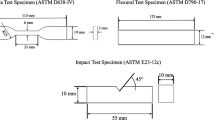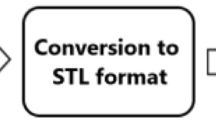Abstract
Fused filament fabrication (FFF) is a widely used extrusion-based additive manufacturing process due to its low operating cost and available material options. Polylactic acid (PLA) is a bio-based compostable polymer extensively used as a feedstock material in FFF. The application of PLA in engineering and medical applications is limited due to the low thermal stability associated with the polymer. The present work aims to study the effect of thermal annealing on FFF-printed PLA in static and dynamic flexural loading. Response surface methodology (RSM) is chosen as a design of experiment method to study the effect of annealing time and temperature on flexural properties of printed PLA. Annealing is found to be advantageous in increasing the dynamic flexural properties. Improved glass transition temperature, stiffness, thermal stability, and crystallinity are also evident with annealing. However, annealing is found to be detrimental in improving static flexural properties. Considering the desirability function (DF) approach, annealing time and temperature are optimised for measured static and dynamic flexural properties. Samples are further investigated in scanning electron microscope for failure mode and differential scanning calorimetry for crystalline behaviour of annealed PLA. Empirical models are proposed for predicting the flexural behaviour of printed PLA. The current study has shown that the FFF-printed PLA can be tailored to specific application requirements due to its stable characteristics for thermal loading with thermal annealing.


















Similar content being viewed by others
Data availability
The authors confirm that the data supporting the findings of this study are available within the article. Any experimental data require in further can be provided by corresponding author upon reasonable request.
Code availability
Not applicable.
Consent to participate.
The consent to participate has been received explicitly from all co-authors.
Consent for publication.
The consent to submit this paper has been received clearly from all co-authors.
Abbreviations
- NA PLA:
-
Non-annealed PLA
- A PLA:
-
Annealed PLA
- XX–YY A:
-
Annealing time–temperature
- FS :
-
Flexural strength
- E :
-
Flexural modulus
- ε :
-
Failure strain
- E' :
-
Storage modulus
- E” :
-
Loss modulus
- Tan (δ) :
-
Damping factor
- T g :
-
Glass transition temperature
- t :
-
Annealing time
- T :
-
Annealing temperature
References
S. S. Crump, “Apparatus and method for creating three-dimensional objects.” Google Patents, 1992
Li H, Taylor G, Bheemreddy V, Iyibilgin O, Leu M, Chandrashekhara K (2015) Modeling and characterisation of fused deposition modeling tooling for vacuum assisted resin transfer molding process. Addit Manuf 7:64–72
Romero PE, Arribas-Barrios J, Rodriguez-Alabanda O, González-Merino R, Guerrero-Vaca G (2021) Manufacture of polyurethane foam parts for automotive industry using FDM 3D printed molds. CIRP J Manuf Sci Technol 32:396–404
H. Klippstein, A. Diaz De Cerio Sanchez, H. Hassanin, Y. Zweiri, and L. Seneviratne, “Fused deposition modeling for unmanned aerial vehicles (UAVs): a review,” Adv. Eng. Mater., vol. 20, no. 2, 2018
Prasad A, Kandasubramanian B (2019) Fused deposition processing polycaprolactone of composites for biomedical applications. Polym Technol Mater 58(13):1365–1398
Zein I, Hutmacher DW, Tan KC, Teoh SH (2002) Fused deposition modeling of novel scaffold architectures for tissue engineering applications. Biomaterials 23(4):1169–1185
Melocchi A, Parietti F, Loreti G, Maroni A, Gazzaniga A, Zema L (2015) 3D printing by fused deposition modeling (FDM) of a swellable/erodible capsular device for oral pulsatile release of drugs. J Drug Deliv Sci Technol 30:360–367
J. W. Comb, W. R. Priedeman, and P. W. Turley, “FDM technology process improvements,” Proc. Solid Free. Fabr. Symp., pp. 42–49, 1994
Sun Q, Rizvi GM, Bellehumeur CT, Gu P (2008) Effect of processing conditions on the bonding quality of FDM polymer filaments. Rapid Prototyp J 14(2):72–80
Carneiro OS, Silva AF, Gomes R (2015) Fused deposition modeling with polypropylene. Mater Des 83:768–776
M. S. Anders Södergard, “Poly ( Lactic Acid ),” Bio-Based Plast. Mater. Appl., no. ii, pp. 27–41, 2010
Viswanath V, Maity S, Bochinski JR, Clarke LI, Gorga RE (2013) Thermal annealing of polymer nanocomposites via photothermal heating: effects on crystallinity and spherulite morphology. Macromolecules 46(21):8596–8607
Dong J, Mei C, Han J, Lee S, Wu Q (2019) 3D printed poly(lactic acid) composites with grafted cellulose nanofibers: effect of nanofiber and post-fabrication annealing treatment on composite flexural properties. Addit Manuf 28(June):621–628
Fischer EW (1972) Effect of annealing and temperature on the morphological structure of polymers. Pure Appl Chem 31(1–2):113–132
Bencid A, Rouabah F, Fois M, Djidjelli H (2017) Effect of the free quenching on mechanical and thermomechanical properties of ABS. Russ J Appl Chem 90(12):2009–2015
Simmons H, Tiwary P, Colwell JE, Kontopoulou M (2019) Improvements in the crystallinity and mechanical properties of PLA by nucleation and annealing. Polym Degrad Stab 166:248–257
Butt J, Bhaskar R (2020) Investigating the effects of annealing on the mechanical properties of FFF-printed thermoplastics. J Manuf Mater Process 4(2):1–20
Akhoundi B, Nabipour M, Hajami F, Shakoori D (2020) An experimental study of nozzle temperature and heat treatment (annealing) effects on mechanical properties of high-temperature polylactic acid in fused deposition modeling. Polym Eng Sci 60(5):979–987
Dong J et al (2017) The influence of grafted cellulose nanofibers and postextrusion annealing treatment on selected properties of poly(lactic acid) filaments for 3D printing. J Polym Sci Part B Polym Phys 55(11):847–855
Yu L, Liu H, Xie F, Chen L, Li X (2008) Effect of annealing and orientation on microstructures and mechanical properties of polylactic acid. Polym Eng Sci 48(4):634–641
Pérez-Fonseca AA, Robledo-Ortíz JR, González-Núñez R, Rodrigue D (2016) Effect of thermal annealing on the mechanical and thermal properties of polylactic acid–cellulosic fiber biocomposites. J Appl Polym Sci 133(31):1–10
Wootthikanokkhan J et al (2013) Crystallisation and thermomechanical properties of PLA composites: effects of additive types and heat treatment. J Appl Polym Sci 129(1):215–223
R. Kotsilkova, I. Petrova-Doycheva, D. Menseidov, E. Ivanov, A. Paddubskaya, and P. Kuzhir, “Exploring thermal annealing and graphene-carbon nanotube additives to enhance crystallinity, thermal, electrical and tensile properties of aged poly(lactic) acid-based filament for 3D printing,” Compos. Sci. Technol., vol. 181, no. May, p. 107712, 2019
Park SD, Todo M, Arakawa K (2004) Effect of annealing on the fracture toughness of poly(lactic acid). J Mater Sci 39(3):1113–1116
Nascimento L, Gamez-Perez J, Santana OO, Velasco JI, Maspoch ML, Franco-Urquiza E (2010) Effect of the recycling and annealing on the mechanical and fracture properties of poly(lactic acid). J Polym Environ 18(4):654–660
Srithep Y, Nealey P, Turng L-S (2013) Effects of annealing time and temperature on the crystallinity and heat resistance behavior of injection-molded poly(lactic acid). Polym Eng Sci 53(3):580–588
Wach RA, Wolszczak P, Adamus-Wlodarczyk A (2018) Enhancement of mechanical properties of FDM-PLA parts via thermal annealing. Macromol Mater Eng 303(9):1–9
S. Bhandari, R. A. Lopez-Anido, and D. J. Gardner, “Enhancing the interlayer tensile strength of 3D printed short carbon fiber reinforced PETG and PLA composites via annealing,” Addit. Manuf., vol. 30, no. October, p. 100922, 2019
Wang S et al (2019) Improving mechanical properties for extrusion-based additive manufacturing of poly(lactic acid) by annealing and blending with poly(3-hydroxybutyrate). Polymers (Basel) 11(9):1–13
S. Wang et al., “Lifting the quality of fused filament fabrication of polylactic acid based composites,” Compos. Part B Eng., vol. 210, no. November 2020, p. 108613, 2021
Li G, Yang B, Han W, Li H, Kang Z, Lin J (2021) Tailoring the thermal and mechanical properties of injection-molded poly (lactic acid) parts through annealing. J Appl Polym Sci 138(2):1–10
S. Rangisetty and L. D. Peel, “The effect of infill patterns and annealing on mechanical properties of additively manufactured thermoplastic composites,” in Volume 1: Development and characterization of multifunctional materials; mechanics and behavior of active materials; bioinspired smart materials and systems; energy harvesting; emerging technologies, 2017, pp. 1–12
Barkhad MS, Abu-Jdayil B, Mourad AHI, Iqbal MZ (2020) Thermal insulation and mechanical properties of polylactic acid (PLA) at different processing conditions. Polymers (Basel) 12(9):1–16
Ivey M, Melenka GW, Carey JP, Ayranci C (2017) Characterising short-fiber-reinforced composites produced using additive manufacturing. Adv Manuf Polym Compos Sci 3(3):81–91
S. M. Senthil, R. Parameshwaran, S. Ragu Nathan, M. Bhuvanesh Kumar, and K. Deepandurai, “A multi-objective optimisation of the friction stir welding process using RSM-based-desirability function approach for joining aluminum alloy 6063-T6 pipes,” Struct. Multidiscip. Optim., pp. 1117–1133, 2020
R. H. Myers, D. C. Montgomery, and C. M. Anderson-Cook, Response surface methodology: process and product optimisation using designed experiments. John Wiley \& Sons, 2016
Dong J, Mei C, Han J, Lee S, Wu Q (2019) 3D printed poly(lactic acid) composites with grafted cellulose nanofibers: Effect of nanofiber and post-fabrication annealing treatment on composite flexural properties. Addit Manuf 28(February):621–628
Mohamed OA, Masood SH, Bhowmik JL (2017) Characterisation and dynamic mechanical analysis of PC-ABS material processed by fused deposition modelling: An investigation through I-optimal response surface methodology. Meas J Int Meas Confed 107:128–141
K. P. Menard and N. Menard, “Dynamic mechanical analysis,” in Encyclopedia of Analytical Chemistry, Chichester, UK: John Wiley & Sons, Ltd, 2017, pp. 1–25
J. Foreman, S. R. Sauerbrunn, and C. L. Marcozzi, Thermal analysis & rheology exploring the sensitivity of thermal analysis techniques to the glass transition 109 Lukens Drive New Castle , DE 19720
Naresh K, Shankar K, Velmurugan R (2018) Digital image processing and thermo-mechanical response of neat epoxy and different laminate orientations of fiber reinforced polymer composites for vibration isolation applications. Int J Polym Anal Charact 23(8):684–709
Derringer G, Suich R (1980) Simultaneous optimization of several response variables. J Qual Technol 12(4):214–219
A. Naveen Sait, S. Aravindan, and A. Noorul Haq, “Optimisation of machining parameters of glass-fibre-reinforced plastic (GFRP) pipes by desirability function analysis using Taguchi technique,” Int. J. Adv. Manuf. Technol., vol. 43, no. 5–6, pp. 581–589, 2009
L. C. Thomas, “Use of multiple heating rate DSC and modulated temperature DSC to detect and analyse temperature-time-dependent transitions in materials,” Am. Lab., vol. 33, no. 1, 2001
Tábi T, Sajó IE, Szabó F, Luyt AS, Kovács JG (2010) Crystalline structure of annealed polylactic acid and its relation to processing. Express Polym Lett 4(10):659–668
Author information
Authors and Affiliations
Contributions
Niranjan Y C has been responsible planning the experiments, conducting the experiments, and analysing all the obtained data. Shankar Krishnapillai and Velmurugan R were responsible for determining the suitable structure and contents of this paper. Their expertise was also necessary in the planning and conducting the experiments.
Corresponding author
Ethics declarations
Competing interests
The authors declare no competing interests.
Additional information
Publisher's note
Springer Nature remains neutral with regard to jurisdictional claims in published maps and institutional affiliations.
Rights and permissions
About this article
Cite this article
Chikkanna, N., Krishnapillai, S. & Ramachandran, V. Static and dynamic flexural behaviour of printed polylactic acid with thermal annealing: parametric optimisation and empirical modelling. Int J Adv Manuf Technol 119, 1179–1197 (2022). https://doi.org/10.1007/s00170-021-08127-7
Received:
Accepted:
Published:
Issue Date:
DOI: https://doi.org/10.1007/s00170-021-08127-7




